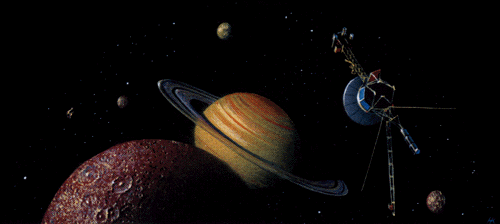

The Solar system.
The Solar system consists of the central luminary - the Sun and of the 9 great planets, rotating around it, their satellites, small planets, comets and interplanet media (see the plan of the Solar system).
The Solar system includes except the central luminary the Sun the nine big planets, their satellites, the number of small planets, comets, small meteor bodies and space dust moving in the sphere of predominating Sun influence. According to the leading theories the generation of the Solar system began from the originating of the central solid - the Sun; the Sunís gravitation field captured the swooping gas and dust cloud which after gravitation generated the Solar system. Due to the Sun radiation the chemical composition of the Solar system was heterogeneous: the light elements (hydrogen and helium are in the outlying planets. The Earth age is determined: it is about 4,6 milliard (billion) years.
The history of the Solar system investigation by N. Copernic (16th century), Kepler (17th century) and I. Newton, who formulated the Gravity Law, then G. Galilei (see earlier this work). The dimensions and the construction of the Solar system.The dimensions of the Solar system are determined by the distance from the Sun to the farthest planet Ė Pluto (about 40 a.u.: 1 a.u.=1,4959841011 mm).
But the sphere around the Sun with the stable celestial solids movement takes more extended zone about 230.000 a.u. and closing the nearest stars spheres.
The big planets moving around the Sun are divided into two groups: the first (internal or the terrestrial includes Mercury, Venus, the Earth and Mars. To the second group belongs to the giant planets Jupiter, Saturn, Uranus and Neptune (the external group). The 9th planet, Pluto, are generally considered separately.
In the central system body the Sun Ė there is 99.866% of all the mass if we donít take into consideration the cosmic dust. The Sun consists of 76% of hydrogen; helium is about 3,4 times less than hydrogen and about 0,75% of all the mass are the rest elements. The same chemical composition the giant planets have. The planets of the terrestrial group are near the Earth in their chemical composition.
The planets and their satellites.Nearly all the planets have satellites and about 90% of their number are grouping around the external planets. Jupiter and Saturn present a miniature similarity of the Solar system. Some of their satellites (Ganimed, Titan) are bigger then the Mercury. Saturn, besides 17 satellites, has the system of rings. The radius of saturn's rings is about 2,3 of the radius of the planet.
The Solar system solids movement. All the Solar system planets rotate around the Sun due to its gravitation and they also rotate around their own axis. The Sun also turns around its axis, but not as a single hard unit. According Effect of Doppler he speed of differ parts of the Sun while rotation is different. On the latitude 16í the period of the full rotation performs 25,38 terrestrial days. The direction of the Sunís and the planetís rotation is the same (except Venus, Uranus and some satellites).The Sunís mass is 330 000 times more than the Earth
The meteors (see the item ďthe small bodies), as well as space dust, fill all the Solar system space. The gravitation and magnetic fields and radiation and particles floods influence their movement. All these factors played the determining role in the Solar system generation from the dust cloud. Inside the Earth orbit the space dust dense is increasing and it forms the cloud, surrounding the Sun, seen from the Earth as a zodiac light.
The Solar system takes part in the Galaxy rotation, moving with the velocity near 250 km/sec. The rotation period around the Galaxy centre is about 200 million years.
Relatively to the nearest stars all the Solar system is moving with the medium speed 19,4 km/sec.